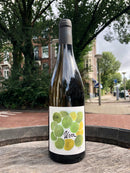Description
Uva Blanc is made from a blend of old Corsican grape varieties of 67% Rimenese and 33% Vermentiniu, or, vermentino as we call it. As we have come to expect from Clos Marfisi, Corsica in a bottle. Expressive, something exotic fruit , mixed with floral and spicy aromas and a handful of white nuts. Gastronomic wine par excellence.
Country / Region: France / Patrimonio (Corsica)
Grape variety(ies): 100% v cermentinium
In the vineyard: Organic farming. Manual harvest. Grapes from vineyards on east-facing slopes with a limestone terroir.
In the wine cellar: Grapes pressed directly . Spontaneous fermentation. Maturation and fermentation in stainless steel. Small amount of sulphite added at bottling.
Quality mark: Biodynamic
In the vineyard: Organic farming. Manual harvest. Grapes from vineyards on east-facing slopes with a limestone terroir.
In the wine cellar: Grapes pressed directly . Spontaneous fermentation. Maturation and fermentation in stainless steel. Small amount of sulphite added at bottling.
Quality mark: Biodynamic
In the beautiful landscape of Patrimonio, Corsica lies Clos Marfisi. Patrimonio has a Mediterranean climate and a very special terroir of clay, limestone, schist and alluvium where great terroir wines can be made. The AOC covers 400 hectares, half of which belongs to the two largest producers of the island and the other half is divided among 30 smaller growers. Clos Marfisi has 15 hectares, spread over the south and east facing, steep slopes of Ravagnola, Gritole and Grotte di Sole.
The very first harvest took place in 1870 and now, five generations later, brother and sister Mathieu and Julie are at the helm of this estate. They took over from their father, Touissant, who always kept away from pesticides and other herbicides, unlike many other winegrowers in the area who did make the switch at the time. Julie and Mathieu, like their father, work completely organically and also received the Bio quality mark in 2018. In addition, they still work with the same vines that their father planted 40-50 years earlier, using only local grape varieties. Only indigenous yeasts are used in the wine cellar and the wine is bottled with as little sulphites as possible. And that is necessary, Mathieu is chairman of the AOC Patrimonio and sets an important example for local viticulture, in which he strives to honour the past and at the same time create a responsible and progressive model for the future.
Secure online payment via
Your payment information is processed securely. We do not store credit card details nor have access to your credit card information.


